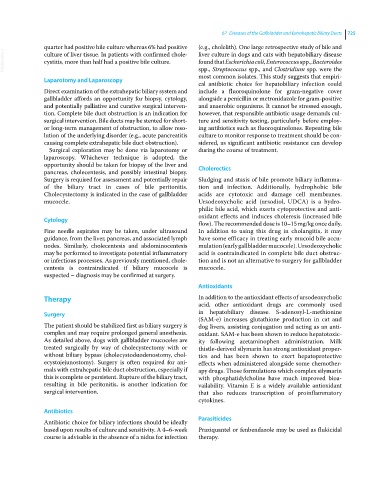Page 757 - Clinical Small Animal Internal Medicine
P. 757
67 Diseases of the Gallbladder and Extrahepatic Biliary Ducts 725
quarter had positive bile culture whereas 6% had positive (e.g., cholelith). One large retrospective study of bile and
VetBooks.ir culture of liver tissue. In patients with confirmed chole liver culture in dogs and cats with hepatobiliary disease
found that Escherichia coli, Enterococcus spp., Bacteroides
cystitis, more than half had a positive bile culture.
spp., Streptococcus spp., and Clostridium spp. were the
most common isolates. This study suggests that empiri
Laparotomy and Laparoscopy
cal antibiotic choice for hepatobiliary infection could
Direct examination of the extrahepatic biliary system and include a fluoroquinolone for gram‐negative cover
gallbladder affords an opportunity for biopsy, cytology, alongside a penicillin or metronidazole for gram‐positive
and potentially palliative and curative surgical interven and anaerobic organisms. It cannot be stressed enough,
tion. Complete bile duct obstruction is an indication for however, that responsible antibiotic usage demands cul
surgical intervention. Bile ducts may be stented for short‐ ture and sensitivity testing, particularly before employ
or long‐term management of obstruction, to allow reso ing antibiotics such as fluoroquinolones. Repeating bile
lution of the underlying disorder (e.g., acute pancreatitis culture to monitor response to treatment should be con
causing complete extrahepatic bile duct obstruction). sidered, as significant antibiotic resistance can develop
Surgical exploration may be done via laparotomy or during the course of treatment.
laparoscopy. Whichever technique is adopted, the
opportunity should be taken for biopsy of the liver and Cholerectics
pancreas, cholecentesis, and possibly intestinal biopsy.
Surgery is required for assessment and potentially repair Sludging and stasis of bile promote biliary inflamma
of the biliary tract in cases of bile peritonitis. tion and infection. Additionally, hydrophobic bile
Cholecystectomy is indicated in the case of gallbladder acids are cytotoxic and damage cell membranes.
mucocele. Ursodeoxycholic acid (ursodiol, UDCA) is a hydro
philic bile acid, which exerts cytoprotective and anti
oxidant effects and induces choleresis (increased bile
Cytology
flow). The recommended dose is 10–15 mg/kg once daily.
Fine needle aspirates may be taken, under ultrasound In addition to using this drug in cholangitis, it may
guidance, from the liver, pancreas, and associated lymph have some efficacy in treating early mucoid bile accu
nodes. Similarly, cholecentesis and abdominocentesis mulation (early gallbladder mucocele). Ursodeoxycholic
may be performed to investigate potential inflammatory acid is contraindicated in complete bile duct obstruc
or infectious processes. As previously mentioned, chole tion and is not an alternative to surgery for gallbladder
centesis is contraindicated if biliary mucocele is mucocele.
suspected – diagnosis may be confirmed at surgery.
Antioxidants
Therapy In addition to the antioxidant effects of ursodeoxycholic
acid, other antioxidant drugs are commonly used
Surgery in hepatobiliary disease. S‐adenosyl‐L‐methionine
(SAM‐e) increases glutathione production in cat and
The patient should be stabilized first as biliary surgery is dog livers, assisting conjugation and acting as an anti
complex and may require prolonged general anesthesia. oxidant. SAM‐e has been shown to reduce hepatotoxic
As detailed above, dogs with gallbladder mucoceles are ity following acetaminophen administration. Milk
treated surgically by way of cholecystectomy with or thistle‐derived silymarin has strong antioxidant proper
without biliary bypass (cholecystoduodenostomy, chol ties and has been shown to exert hepatoprotective
ecystojejunostomy). Surgery is often required for ani effects when administered alongside some chemother
mals with extrahepatic bile duct obstruction, especially if apy drugs. Those formulations which complex silymarin
this is complete or persistent. Rupture of the biliary tract, with phosphatidylcholine have much improved bioa
resulting in bile peritonitis, is another indication for vailability. Vitamin E is a widely available antioxidant
surgical intervention. that also reduces transcription of proinflammatory
cytokines.
Antibiotics
Parasiticides
Antibiotic choice for biliary infections should be ideally
based upon results of culture and sensitivity. A 4–6‐week Praziquantel or fenbendazole may be used as flukicidal
course is advisable in the absence of a nidus for infection therapy.

